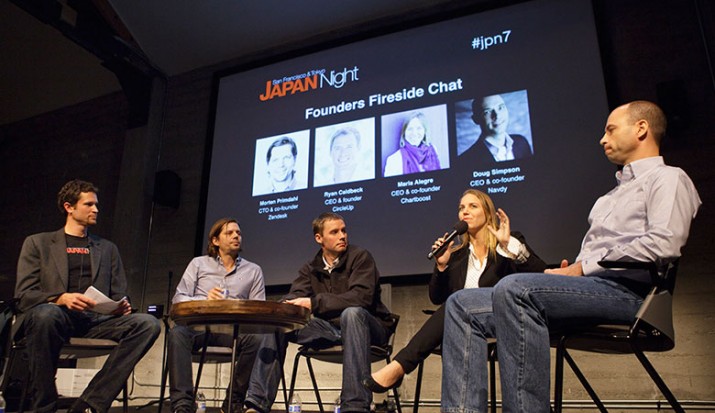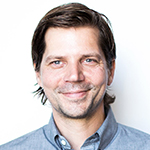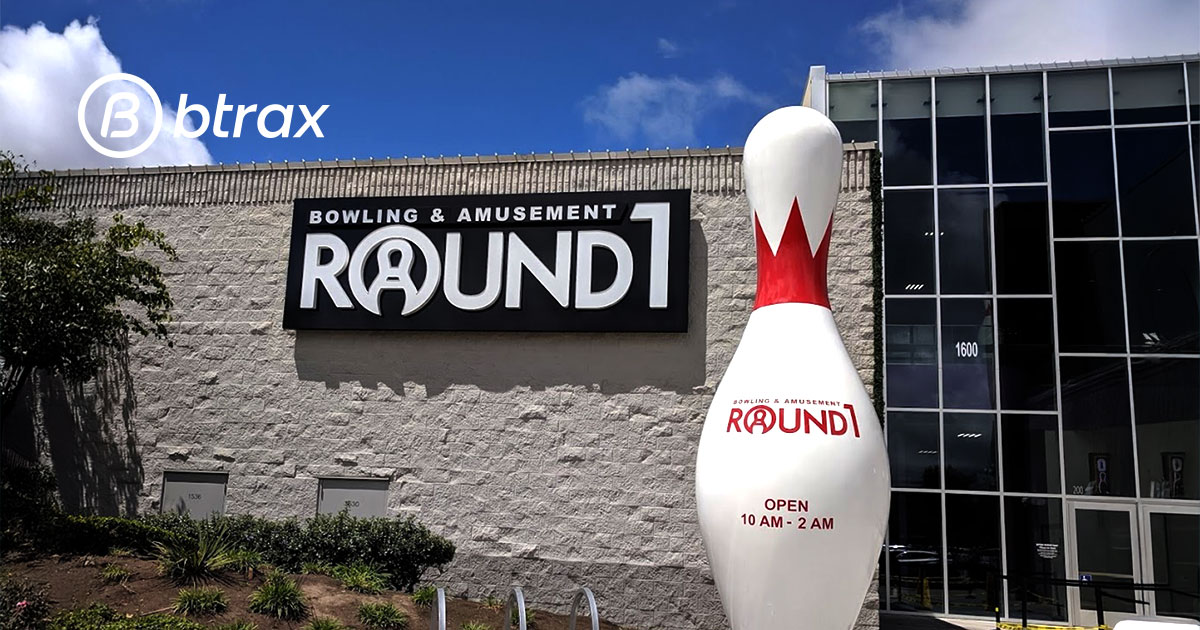
Btrax Design Company > Freshtrax > Becoming an Ent...
Becoming an Entrepreneur – What Inspires Startups
We hear a lot of stories about entrepreneurs who drop out of college (or even high school) to start their own companies. But what about those who started out in the corporate or academic world and became entrepreneurs later in their career?
I sat down with four co-founders of successful startups from seed stage to IPO at JapanNight VII to learn about what inspired them and how they built their company. This is the first part of my Founders Q&A series (read the second part here).
Founder Profiles
 |
Morten Primdahl CTO & co-founder of Zendesk Zendesk is a software development company providing a cloud-based customer service platform. Morten co-founded Zendesk with Mikkel Svane and Alexander Aghassipour, and has served as the Chief Technology Officer since August 2007. |
 |
Maria Alegre CEO & co-founder of Chartboost Chartboost is the largest revenue platform for mobile games. Prior to Chartboost, Maria was an early employee at mobile game studio Tapulous, where she oversaw product launches and marketing. Maria holds a B.A. in Business from the University of Michigan and the ESADE Business School in Barcelona, Spain. |
 |
Ryan Caldbeck CEO & founder of CircleUp CircleUp is an online private company investment platform. Ryan started CircleUp after almost seven years of investing experience in consumer product and retail-focused private equity at TSG Consumer Partners and Encore Consumer Capital. Ryan has a dual B.A. from Duke and received his MBA from Stanford. |
 |
Doug Simpson CEO & co-founder of Navdy Navdy is a Head-Up Display (HUD) that displays information from your phone and car as a transparent image that appears to float outside of your windshield. Prior to Navdy, Doug founded Hawkeye and SmartRoam, and held senior roles in R&D and sales at Hewlett-Packard. |
Q&A
Tim: What was the inspiration for your company and what were the early days like?
Morten: Back in 2004, I was working with my now co-founder Mikkel Svane selling million dollar licenses and million dollar hosting to big enterprise software systems. We realized that these products could be so much better: they were really expensive, complicated and had bad UI/UX. So we identified the problem and decided to solve it by making it cheaper and better. We saw room for transparency in the market, so that’s when we started thinking: “How can we build something better?”
Ryan: I was working as an investor. It wasn’t very fulfilling to me, so I spent a lot of time thinking about what makes me happy. I think the thing that my co-founder and I settled on was helping others be successful. What we found was that there’s a market out there for entrepreneurs that struggle to raise money, and that’s why we started CircleUp.
We started thinking: How can we build something better?
– Morten Primdahl, CTO & co-founder of Zendesk
Maria: My co-founder and I were making games before Chartboost. We were a company called Tapulous – it was one of the very first gaming companies for the iPhone, even before the app store existed. We were making games and we realized that to create a business behind the game, we had to build all this technology to promote it–to optimize advertising and to push new content into the game without having to submit updates to the app. So we built all this backend technology to power the business side of games.
After Walt Disney bought the company, we realized that mobile gaming was still in its early days, so we wanted to build technology for future game developers to create successful businesses behind their games. We started with distribution and monetization, which were our two priorities, but there’s so much more to do.
Doug: I started Navdy because I wanted to use the product. I was frustrated with using my phone in the car and having to look down to find a contact or read an SMS message, sometimes almost causing an accident. I thought there had to be a way to provide a much better experience that’s also safer.
Tim: How did your background in terms of your education and work experiences influence how you became an entrepreneur?
Morten: I was actually a chemical engineer and was planning on getting a Master’s degree in civil engineering, but then I realized that maybe this was not what I wanted to do. I couldn’t see myself dealing with enzymes and wearing a lab coat, so I decided to change my path. It was 1999, during the dot com boom, and I took a job at a small startup. I did that for a year or two; I always loved computers and the internet so I really liked it there. I never went back to chemistry. Instead, I went on to get a Master’s in Computer Science.
I realized that I could either solve other people’s problems for the rest of my life, or I could try to see what else is out there.
– Morten Primdahl, CTO & co-founder of Zendesk
In terms of entrepreneurship, Denmark is a small country, so if you go into computers, you can go into consulting or banking. I was in consulting for a while until I realized that I could either solve other people’s problems for the rest of my life, or I could try to see what else is out there. That, combined with the changing landscape of Silicon Valley years ago, pushed my co-founder and me to give this a shot.
Tim: How did you make that leap from your previous role to being a co-founder?
Morten: In the early stage, you have to do whatever it takes to build your company and make it succeed. I took on the role of CTO because I’m just the most technically-minded of the three co-founders, and the same goes for the rest of us. We speak the same language but have strengths in different areas, and that’s one reason for our success.
Ryan: I think my experience as an investor shaped what started CircleUp in two ways. One: Inspiration. I was bored with what I was doing and wanted to build something bigger to help others. Two: I think the knowledge necessary to do what we’re doing isn’t something that you can just pick up. It’s what I spent my whole career doing, so this experience allowed us to solve some problems that others before us were not able to solve. A large part of that was because they weren’t ingrained in the same way.
I spent a lot of time thinking about what makes me happy.
– Ryan Caldbeck, CEO & founder of CircleUp
Maria: I moved to Silicon Valley six years ago from Barcelona. As you mentioned earlier, I went to business school and always wanted to start a company. But in Spain, they tell you that you can’t do that until you’ve worked for 10 years. So I finished business school and went into strategic consulting. I worked at both McKinsey and Deloitte, and there, I learned what I didn’t like to do. I learned a lot about how people think in a structured way, but I didn’t like to have my future planned for the next seven years. There had to be something else out there.
I started listening to a podcast from Stanford University where they had entrepreneurs share their experiences. That’s how I learned about Silicon Valley. So after trying what I didn’t like, I decided to move to Silicon Valley to explore what it was all about and be surrounded by the entrepreneurial spirit. I wanted to be close to people who felt like they were building big things and changing the world. That’s how I moved from consulting and finance to entrepreneurship.
I wanted to be close to people who felt like they were building big things and changing the world.
– Maria Alegre, CEO & co-founder of Chartboost
Doug: I started my career at Hewlett-Packard. I learned a lot working there and was very lucky that I always ended up in divisions that felt almost like startups inside of HP. They were usually new initiatives and new business units that are very small starting out, but then grow into much larger businesses.
What was most exciting to me was the early stages–growing something from nothing. Fortunately, I got to learn about that in a lot of ways in HP, but of course, doing it on your own outside of a big company is much harder. After realizing that that’s what I loved to do, it was a natural progression to do it on my own after working with HP.
Key Takeaways
Although every entrepreneur has a different story, one thing all the founders have in common here is the desire to find out if there’s something better out there.
They didn’t come out of school and become entrepreneurs straight away. Instead, they went on to do something they didn’t necessarily love, only to come to the epiphany that they should try something else.
With the right kind of drive and the right idea, your background shouldn’t get in the way of you establishing your own company. What you need is persistence and passion for building something from the ground up, and the desire to make your life as fulfilling as possible.
Photo by: Mark Avery
Check Out Our FREE E-Books!
Discover our FREE e-books packed with valuable research and firsthand insights from industry experts!
Dive into our collection below, and stay tuned – we’re constantly adding new titles to keep you ahead of the curve.
- Big in Japan: Global Brands Thriving in the Japanese Market, Vol. 1
- A Guide to the Promotional Seasons in Japan
- What I Wish I Knew Before Entering the Japanese Market
- 100+ Facts to Understand the Motivations Behind Japanese Behaviors
- Insights on Japan’s Changing Workstyle
- Insights into Japan’s E-Commerce and Direct to Consumer (D2C) Market







